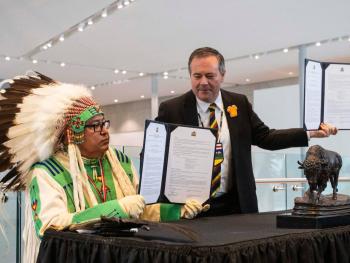Image Caption
Summary
Local Journalism Initiative Reporter
Windspeaker.com
Leonard Bastien, knowledge keeper, Elder and chair of the Manitou Asinîy-Iniskim-Tsa Xani Center, said it was several years ago that he and Blaine Favel, former chief of the Poundmaker Cree Nation, visited the Manitou Asinîy, or Manitou Stone, currently housed at the Royal Alberta Museum in Edmonton.
Bastien and Favel had spoken for many years about the meteorite, known by many names, including awâsis kôhtakocihk kîsikohk (the child who fell from the sky). The men had an overwhelming desire to bring the stone back to where it had fallen to earth near Hardisty, Alta., about 100 kms from the Saskatchewan border.
“It was always on my mind,” explained Bastien.
The Manitou Asinîy is of great spiritual significance to the Indigenous people of Alberta and Saskatchewan. Weighing in at 145 kg, the Manitou Stone came crashing through earth’s atmosphere thousands of years ago and its resting place served as a location where tribes would gather in search of peace and healing. It was said to protect the buffalo herds, which were central to the lives of the Prairie First Nations.
“If I interpret the stories and relate what I heard as a young man in our beliefs and our philosophy, the Creator gave us the buffalo and this was from where my community was. This is from the northern area where we had access to the buffalo. And prior to 1860, the Blackfoot people went up there and already had this connection to this rock. They would have ceremony there. They would have a spiritual connection, for their connection to the buffalo, for survival, for their beliefs and for healing. That was the stories I heard as a young man,” Bastien told Windspeaker.com.
In 1866, Reverend George McDougall, a Methodist missionary, removed the stone from its original landing spot, so that location remained a mystery.
In February 2021, Favel, Bastien and other Elders held a ceremony at the Manitou Stone in the museum in Edmonton where Elders told stories about the heritage of the iron rock, the powers it holds and the need for it to be returned and to be housed where the nations could have access to it for ceremony.
“The planets all aligned that day,” said Bastien.
Soon after the ceremony, connections began to be made with the tribes within the buffalo culture and with government officials. That led to in-depth discussions about how to repatriate the stone to its original location and to a purpose-built interpretative and healing center.
It was discovered that the original location of the Manitou Asinîy had been dug up and now housed a gravel extraction pit.
“We went up to the location and had a sweat lodge in June of 2021 and October 2021. And then we went back to Edmonton and had ceremony at the rock itself and from there began to organize as a group and continued to move forward,” Bastien said.
The group met with the current landowners, MLAs, members of the Royal Museum of Alberta and Indigenous leaders.
“The task at hand was to get support from the tribes that had a connection to the rock, that are part of the buffalo culture. And we got support from these tribes and as it worked out on Sept. 30 the rock was turned back over to us to work with a joint stewardship process in repatriating the rock back to its original location,” Bastien said.
Bastien and former Alberta premier Jason Kenney signed a co-stewardship agreement that will allow funding in the amount of $500,000 to help with the process of holding meetings, creating plans and working with an architect to build a facility to house the stone.
“We really do try and want to engage in meaningful ways with our Indigenous nations that we share this land with,” said Minister of Culture Ron Orr. “This is one of those things that they have asked us for, that they have asked about. It’s not a new ask. It’s an old one.”
Bastien said he thinks it will still be a couple years until the project is complete, but once the stone is brought back to its home it will provide a place where people can gather and learn about the history, culture and science of it.
“It is a big-ticket item for education people to include land-based education,” he said. “For me as a young man up to now it is that land-based education that has made a significant positive difference in my life and who I am today.
“With this repatriation and the access to it, yes, there will be that education that would be provided from a historical perspective and looking at the astronomy, astrology, cosmic and meteorites … There’s a thirst and hunger from the young people to learn more about their cultural roots, and so this rock will assist in that. It’s not going to totally be the focus that’s going to help them, but it will play a significant role in assisting with that the history of our buffalo culture.”
Local Journalism Initiative Reporters are supported by a financial contribution made by the Government of Canada.

